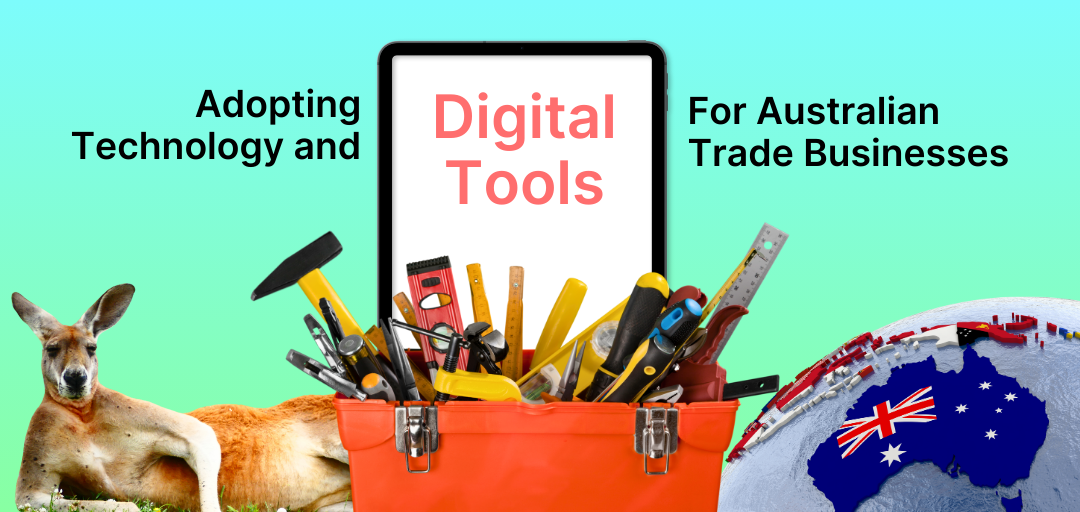Tech and Tools For Australian Trade Businesses

Oct 01, 2024 • 4 min read
Discover how Australian trade businesses can thrive in a digital world by adopting key technology tools. From job management software to virtual assistants, learn how to streamline operations, reduce costs, and enhance customer service for long-term success.
Technology is reshaping industries across the globe, and the Australian trade sector is no exception. From plumbers and electricians to builders and carpenters, trade businesses are increasingly turning to digital tools to streamline their operations, improve customer service, and stay competitive. But with so many options available, it can be overwhelming to figure out where to start. In this blog, we’ll explore the most effective technology and digital tools that can help Australian trade businesses thrive in an increasingly digital landscape. Whether you're looking to improve efficiency, reduce costs, or enhance communication with clients, embracing the right tools can be a game-changer for your business.
Key Digital Tools for Trade Businesses in Australia
The good news is that there are many digital tools specifically designed for trade businesses. Here’s a rundown of some of the key tools that Australian tradespeople should consider adopting:
1. Job Management and Scheduling Software
Managing jobs, appointments, and schedules is a critical task for trade businesses. Tools like ServiceM8, SimPRO, and Tradify allow you to schedule jobs, assign tasks to your team, and even communicate with clients in real time. These platforms also enable users to generate quotes, track work progress, and manage invoices, all in one place.
2. Accounting and Invoicing Tools
Staying on top of finances is crucial for any business. For trade businesses, accounting tools like Xero, QuickBooks, or MYOB help manage invoicing, payments, and expenses. These tools integrate with other software, allowing for a seamless flow of information between operations and finance. They can also assist with tax reporting, payroll, and compliance with Australian regulations.
3. Mobile Applications
Many of the tools available for trade businesses also come with mobile applications, allowing workers to access critical information on the go. Apps like Tradify and Jobber allow tradespeople to manage jobs, communicate with clients, and capture photos or documents from the job site, all from their smartphone or tablet.
4. Cloud Storage and Collaboration
Cloud storage platforms like Google Drive or OneDrive are invaluable for storing and sharing important documents. Whether it’s contracts, safety protocols, or customer information, cloud-based storage ensures that your data is secure, easily accessible, and can be shared with employees or clients at any time.
5. Outsourcing and Virtual Assistants
Reduce overhead costs associated with hiring full-time employees. VAs can handle administrative tasks like scheduling, customer service, and invoicing, allowing you to focus on your core services. With flexible contracts and remote work arrangements, businesses can scale support as needed without the expense of office space or equipment. This helps trade businesses stay competitive, efficient, and more profitable.
Tips for Integrating VAs with your Aussie Trade Businesses
1. Identify Key Tasks:
Start by determining the tasks that can be delegated to a VA, such as customer inquiries, appointment scheduling, invoicing, social media management, or document organisation. Focus on administrative or repetitive tasks that take time away from your core business functions.2. Choose the Right VA:
Find a VA with experience in supporting trade businesses or relevant administrative skills. You can search for VAs through specialized platforms, or work with an outsourcing agency. Ensure they are familiar with local business practices, time zones, and specific software used by your business.
3. Set Clear Communication Channels:
Establish efficient communication methods, such as email, phone, or project management tools (e.g., Slack, Trello, or Asana). This ensures the VA can stay connected and updated on your business needs.
4. Train and Onboard the VA:
Provide a comprehensive onboarding process to explain your business operations, preferred tools, and specific workflows. Clear instructions on tasks and expectations will help the VA integrate smoothly into your business.
5. Monitor and Evaluate Performance:
Regularly assess the VA’s performance to ensure tasks are being completed effectively and within your deadlines. Offering constructive feedback helps improve their performance over time.
Tips for Adopting Technology in Your Trade Business
Transitioning to a more digital business model doesn’t happen overnight. It requires planning, learning, time, and sometimes an upfront investment in training or equipment. Here are a few tips to ensure a smooth adoption of technology in your trade business:
1. Prioritise Integration
When selecting digital tools, choose solutions that can integrate with each other. For example, your accounting tool should ideally sync with your job management software to avoid the need for manual data entry.
2. Start Small
Don’t try to adopt every new tool all at once. Start with one or two key tools that will offer the greatest return on investment. For example, try implementing job scheduling software first, and then consider adding inventory management or CRM tools as you become comfortable.
3. Invest in Training
Many digital tools are user-friendly, but there’s still a learning curve. Invest in training for your team so they can make the most of the software. Online tutorials, webinars, and customer support can help ease the transition.
4. Seek Customer Feedback
As you adopt new technologies, ask your customers how their experience has changed. Whether it’s easier invoicing, better communication, or quicker service, getting feedback will help you continuously refine your digital strategy.Conclusion
Adopting technology and digital tools in Australian trade businesses isn’t just a trend—it’s essential for staying competitive and efficient in a modern marketplace. Whether you’re looking to streamline your operations, improve customer service, or simply stay organized, digital tools and outsourced virtual assistants can be the solution. By taking small steps to embrace technology, your trade business can unlock new growth opportunities, provide better service, and create a more streamlined, profitable operation. The future of the trade industry is digital, and those who adapt early will be the ones to thrive.
NEWS AND BLOG
Resources for boosting
your business

Tech and Tools For Australian Trade Businesses
Discover how Australian trade businesses can thrive in a digital world by adopting key technology to…
Read more..

Inside the Remote Workspace: A Compilation of WFH Setups from Our Featured Developers
Discover how CC.Talent's remote developers thrive in a flexible work environment. Learn their tips f…
Read more..

The Ultimate Showdown: Which AI Coding Assistant Boosts Developer Productivity the Most?
Explore a comprehensive comparison of top AI-powered coding assistants, including GitHub Copilot, AW…
Read more..
REQUEST A QUOTE
Start building your winning team for the now and next
Lorem ipsum dolor sit amet, consectetur adipiscing elit, sed do eiusmod tempor incididunt ut labore et dolore magna aliqua. Ut enim ad minim veniam, quis nostrud exercitation
.png?width=4394&height=835&name=CC.Talent%20-%20without%20tagline%202%20(1).png)
